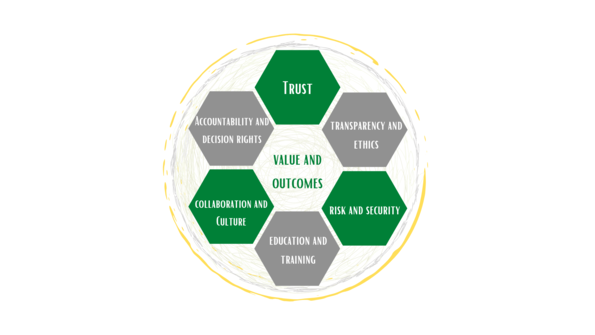MODERN DATA AND ANALYTICS
7 Key Foundations of Modern Data and Analytics Gouvernance
This article will cover the 7 Key Foundations of Modern Data and Analytics Gouvernance, Facts or figures and information stored in or utilized by a computer are called “data.” They are facts that can be evaluated or used to learn more or make better decisions. The science of studying raw data to conclude it is known as data analytics. Many data analytics approaches and processes have been mechanized into mechanical techniques and algorithms that deal with raw data, and they are intended for human consumption. Data analytics techniques can be applied to any data to gain knowledge that can be utilized to improve things. Data analytics techniques can discover trends and metrics that might otherwise be lost in a sea of data. This data can then enhance a company’s or system’s overall efficiency by optimizing procedures. Manufacturing organizations, for example, frequently record the runtime, downtime, and work queue for various machines, then analyze the data to better schedule workloads so that the devices function at near-peak capacity. Data analytics can do a lot more than identifying production bottlenecks.
However, data and analytics governance is all about maximizing the value of data and lowering the time and expense of gaining insights. Data governance encompasses tasks such as data definitions, discovery, data quality, and data lineage and is what most BI (Business Intelligence) firms envisage when they think of “governance” Analytic governance entails concentrating on both the technologies utilized and how to manage them to maximize the value of data for the company. It incorporates particular measurements and key performance indicators (KPIs) that drive the business. It is just as critical to control these as it is to prevent the data. In the meantime, data analytics governance has seven essential foundations, making them very effective in many domains.
There are seven key foundations for Data and Analytics governance, such as Value and Outcomes, Accountability and Decision rights, Trust, Transparency and Ethics, Risk and Security, Education and Training, and Collaboration and Culture.
Relate the governance of data and analytics with business outcomes
Governance efforts should be inextricably linked to business strategy and priorities. Organizations, on the other hand, frequently focus their D&A governance practices on data rather than business, making it difficult for D&A leaders to have meaningful discussions with business leaders.
Align governance policies and standards with business priorities, business process metrics, and D&A metrics to better support business outcomes.
Put business value and prioritized outcomes at the heart of your governance charter, and establish clear business metrics for success. Ascertain that these metrics are assigned to specific stakeholders and are linked to D&A metrics.
Ultimately, organize workshops with key decision-makers to discuss strategies for improving business results.
Maintain an accountability and decision-making methodology
Any effective D&A initiative requires a paradigm of responsibility and decision rights. This offers the necessary supervision to guarantee that the proper individuals are held responsible for their actions and that stakeholders have faith in the governance decision-making process.
Instated trust-based governance
Because data and analytics assets exist throughout an organization and vary in type, making business decisions based on the notion that “all information is equal” is no longer a viable option. Instead, create a governance paradigm built on trust that:
- Aids in the development of a distributed D&A ecosystem.
- Recognizes the many asset lineages and curation
- Assists corporate executives in making more confident contextually relevant judgments.
Examine how tools like a data catalog may assist you in discovering, evaluating, and managing data and analytics assets throughout the corporate ecosystem.
Respect for digital ethics and transparency
D&A governance must work on the principles of transparency and digital ethics in order for digitalization to be effective. Decisions on data and analytics governance should be explicit, justified, and recorded. As a data and analytics leader, you should create a digital ethical framework that can be adopted across the company.
Ascertain that your data and analytics governance charter is consistent with your organization’s corporate values and digital ethical standards. Make certain that it specifies appropriate authorities and accountability, as well as the reason for decisions.
The operational procedures for data and analytics governance should show a clear audit trail showing decisions made, actions done, related investments and expenditures, and compliance with digital ethics.
Identify the risk management and information security
Top-performing businesses are risk-aware, not risk-averse. This implies that they handle both the dangers and the possibilities provided by data and analytics. Organizations frequently govern business opportunity and risk separately, and they also fail to include information security as a critical component when assessing business outcomes.
D&A governance bodies should have interdisciplinary teams that can make balanced choices, giving appropriate weight to opportunity, risk, and security, and keeping organizations’ long-term interests in mind.
The criteria used to evaluate governance choices should show business value, future risks and opportunities, and information security deficiencies. Establish a control environment and connect it with the business information security architecture to handle D&A threats in real-time.
Implement governance education and training
D&A governance efforts need that individuals behave differently by adhering to the expectations set by rules and standards. However, it is not always apparent what these new behaviors should be. Collaborate with HR to build a learning and development program to promote best practices in data governance. Analyze governance-related jobs to determine the needed skill set, and then create training modules that include webinars, blogs, or guidelines to give relevant and up-to-date learning material. Evaluate their influence on assisting individuals in making better governance decisions and make the required improvements.
Support cultural transformation and collaboration
Because D&A governance decisions are made across the enterprise, collaboration rather than centralization should be prioritized. D&A governance should not be viewed as a bureaucratic activity; instead, it should emphasize interpersonal connections, storytelling, information sharing, and creativity.
Begin by attending executive meetings, all-hands meetings, and other sessions to gain a feel of how data is currently regarded in the business. Determine what cultural changes are required and create a story-based narrative to illustrate how data and analytics governance may address real-world issues that contribute to digital weariness.
Zen Networks is a leading provider of advanced IT solutions, specializing in log monitoring, automation and DevOps.
Our expert team offers a wide range of services, including IT monitoring, cloud services, agile solutions, and automation. We are also well-versed in the installation and implementation of Elasticsearch, Logstask, and Kibana on Docker.
By leveraging our extensive domain expertise and innovative technologies, we empower our clients to optimize their IT infrastructure and achieve operational excellence. Our solutions are designed to help organizations of all sizes to streamline their processes, improve efficiency, and reduce costs.
We invite you to take advantage of our complimentary consultation and quote service to learn more about how we can help your organization to achieve its IT goals. Contact us now to schedule your consultation and discover the benefits of working with Zen Networks.
Author





